The Alfettina was the first of a series of cars which were to comprise the retro-monoposto class of race cars. The retro monoposto performance goals are more experiential, rather than purely speed-oriented. The concept was designed to bring the fun and passion of sportsman's racing back to the track. We've endeavoured to create a class which is accessible to the weekend driver.
We initially posted this page in the hopes of getting critical mass for a small class or racing group. Against our better judgement, and certainly at odds with our normal reluctance to work with other people, we were willing to gear-up for some limited production of bodies, chassis, and other bits if there was sufficient interest in the concept. In late 2001 we had a person contact us about doing fifty of these cars for a track in Europe, but it appears that the fellow was just blowing smoke (vindicating our earlier philosophy of avoiding commercial ventures!). This doesn't seem to be happening, so we are going to table the production idea for the foreseeable future. If the right situation presents itself later on (in the form of someone or some group willing to cough up the funds required to lure us out of our metaphorical caves), we might be tempted to go ahead with a small production of components, but this is less likely all the time. We will leave this page up as an inspiration and interest-builder, and as an example of what the Legends-type racers could have looked like!
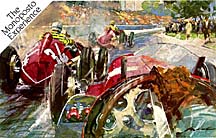 How can normal, everyday drivers with no race track training experience classic motor racing without the lethal consequences? We change two elements. First, we scale everything down so that things seem to happen faster, even though the actual speed is slower (1950's Formula 3 speeds). And second, we run the competitions on skinny tires. This means we have to control the car with the same concentration and finesse as a Grand Prix driver at speeds above 150. When we "overcook it" and slide off in a corner, and onto the safety apron, we come to an easy stop, and try again.
How can normal, everyday drivers with no race track training experience classic motor racing without the lethal consequences? We change two elements. First, we scale everything down so that things seem to happen faster, even though the actual speed is slower (1950's Formula 3 speeds). And second, we run the competitions on skinny tires. This means we have to control the car with the same concentration and finesse as a Grand Prix driver at speeds above 150. When we "overcook it" and slide off in a corner, and onto the safety apron, we come to an easy stop, and try again.
The speeds of the cars are kept within sane limits while maintaining a high level of driving excitement. Impossible, you say! Not if one sets out from the start to maximise fun, rather than speed. This way we can all feel the thrill of being at the wheel of a classic front-engine, monoposto racer, trying to keep cool and stay ahead of the pack.
There is a reason why so many of the legends of motor racing state over and over that the most real fun they had in their careers was racing the 1950's Formula Three cars. Being able to mix it up for sport, not glory or profit, and without lethal consequences, makes for the most satisfying motoring fun!
Most of the pictures on this page are links to larger views; click on them if you'd like a closer look.
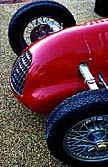
Everyone has their own favourite style of classic single-seat racer (maybe more than one!), and chances are, one of the cars below will strike a chord with you. The retro-monoposto series lends itself well to all sorts of single-seat racers from the 1930's through the 1950's, and the Alfettina above was hoped to be only the first of a series we would eventually do, including cars based on European formula racecars and American Speedway racers. Below are some of the directions the next set of cars could have taken.
Just as the Alfettina above is inspired by Italian cars (notably Alfa), the other cars in the series would each evoke the essence of their own inspiration. The shape and trim for each style of car should be true to the type to bring the driver as close to the experience as possible.
All of the different cars would want to be competitive with one another within the retro-monoposto class. The engines, front and rear suspensions, wheels and tires, chassis, and brakes would be the same for all the cars (except the Auto-Union, which requires a bit different set-up), giving the series a chance to sort out drivers without getting into a spending-race. The Auto-Union would have to be a mid-engined layout, in keeping with the Auto-Union's history, but power would need to be kept within similar levels as the front-engined racers. This could have made for some interesting racing, while allowing quite a range of differing styles and driving "feels", but as no one has been willing to foot the bill for these cars, they're likely to stay in the realm of the pipe-dream.
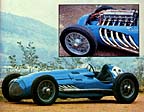
Similar to the Alfettina, but with a French flair. Somewhat like a truck, the post-war Talbot-Lagos were slightly outclassed by their competition, but utterly reliable and economical with their big, lower-stressed engines. They ended up being very competitive as they could out last the competition, both for fuel and reliability. A good looking car, and well regarded.

A W25C; Manfred Von Brauchitsch at Nurburgring in 1936.
The Mercedes and Auto-Union teams almost entirely dominated the late Thirties Formula 1 racing scene. The performance both companies were able to reach demanded the most able drivers, regardless of nationality. The Mercedes team was amazingly well prepared for races, and their cars were reliable as well as fast. These cars (of both teams) were technological marvels, with that ultra-machined German look under the bonnet/hood and beautiful, sleek bodies.
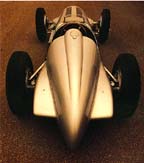
A 1937 W125.

An overhead view of a W25C.
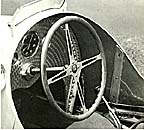
A view of the cockpit of a W125.
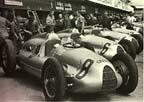
Type D Auto-Unions in the pits.
The rivalry between Auto-Union and Mercedes was pretty fierce, but generally good-natured. With their revolutionary mid-engined layouts and outstanding power (500 to 600 Hp. for both teams), Auto-Unions set a number of performance records which stood for decades. The running gear of the Porsche designed Auto-Unions bears a remarkable resemblance to the Volkswagen, which was designed at the same time by Dr. Porsche. The visual style of the A-U Rennwagens is sort of medieval-armor feeling (in a good way!).
The size constraints of the retro-monoposto class make the Type D the only plausible Auto-Union version for the retro-monoposto. Though it would be nice to do an earlier car as well (a mix of Type A and Type C), the shape of the older A-U's dictates a full-size car.
Ed.Note: Having re-read this, I'm not so sure one couldn't squeeze a Type A/C hybrid together in the proper scale. It might work.
Here are a couple of examples of cars prepared for American speedway racing. Click on either photograph to see some more and larger images of other representative cars.
A representative car or two could be done with more of an American flair. It could still have the same types of running gear and be competitive.
By downloading the Acrobat PDF file below, which contains elements to make up a car, you can experiment with different colour schemes to your hearts content.